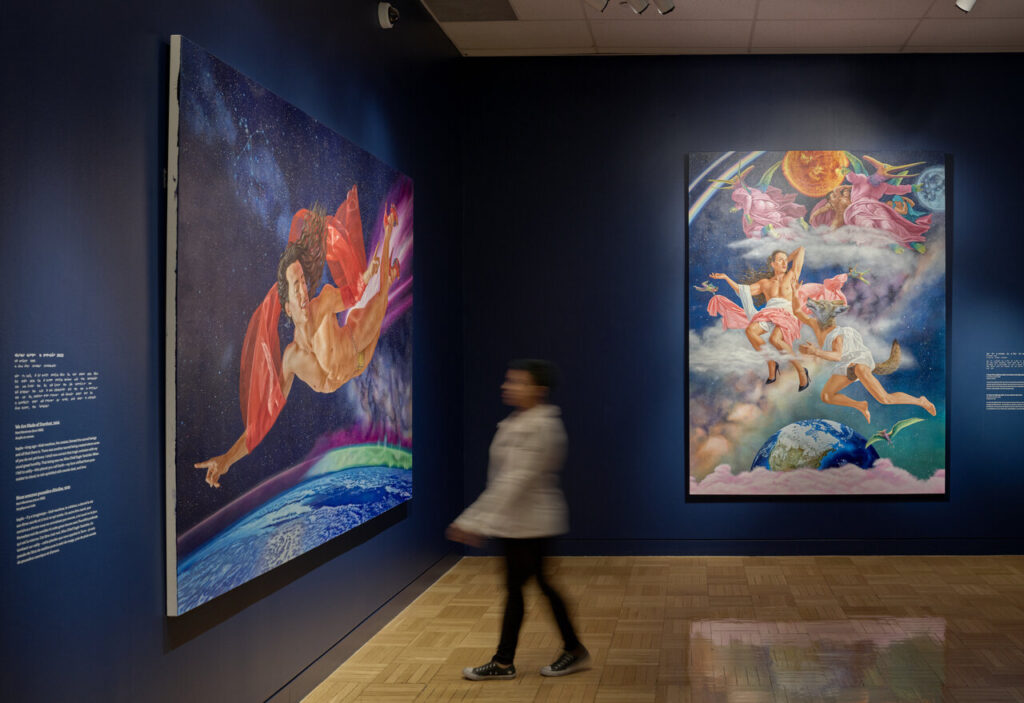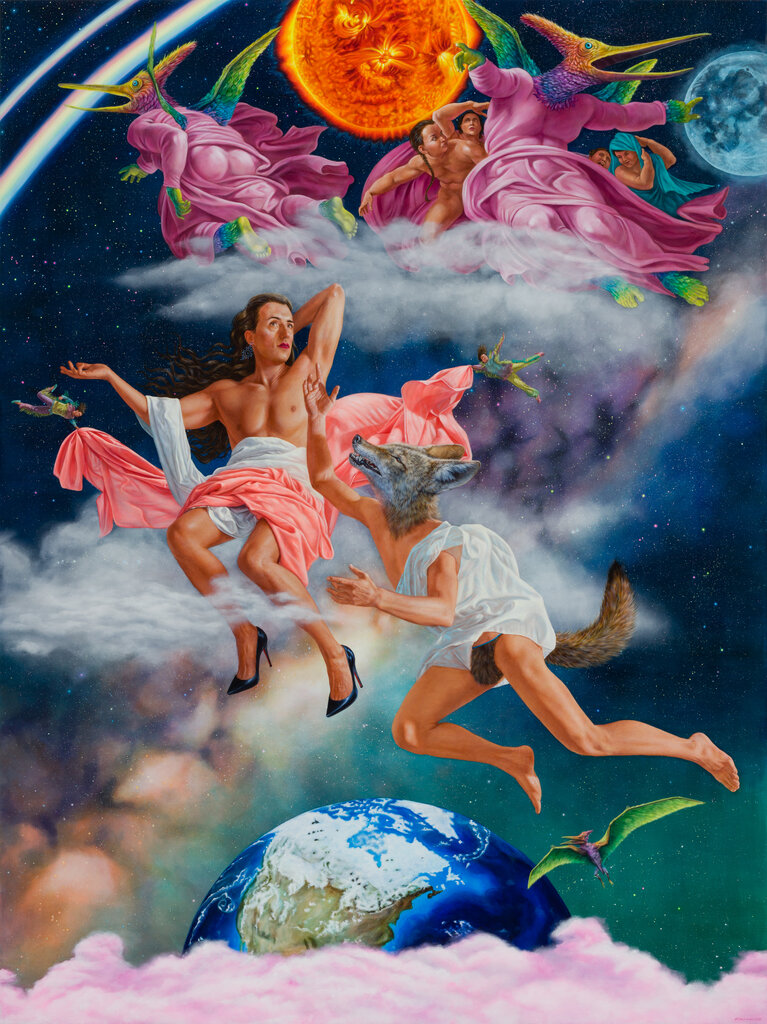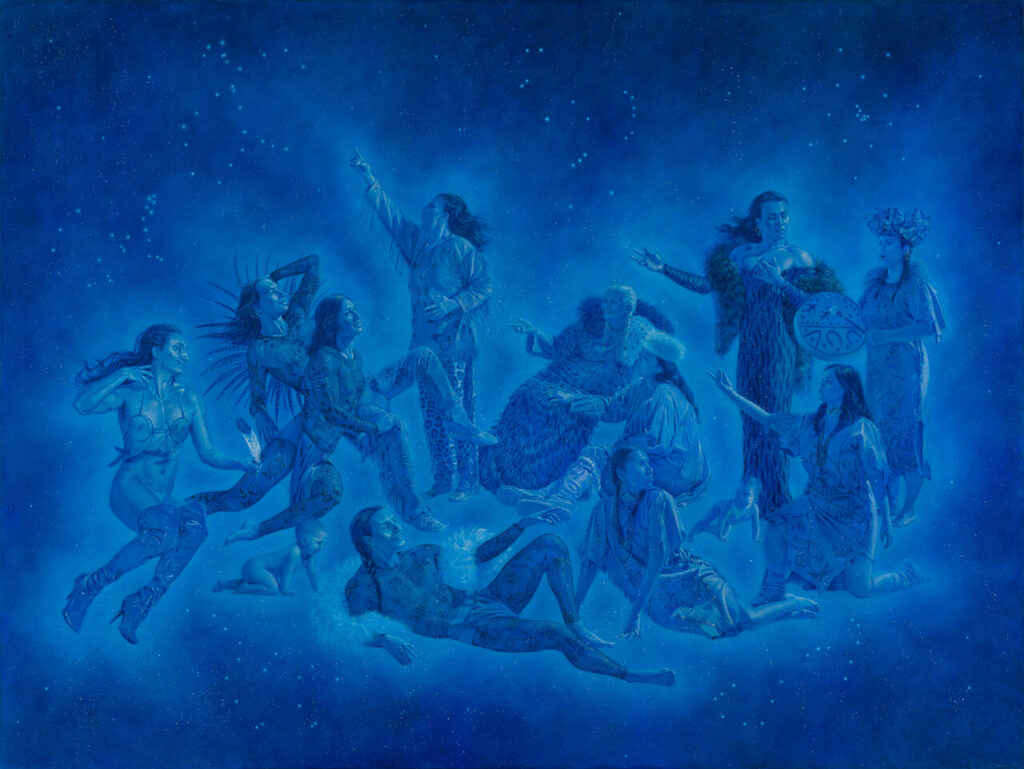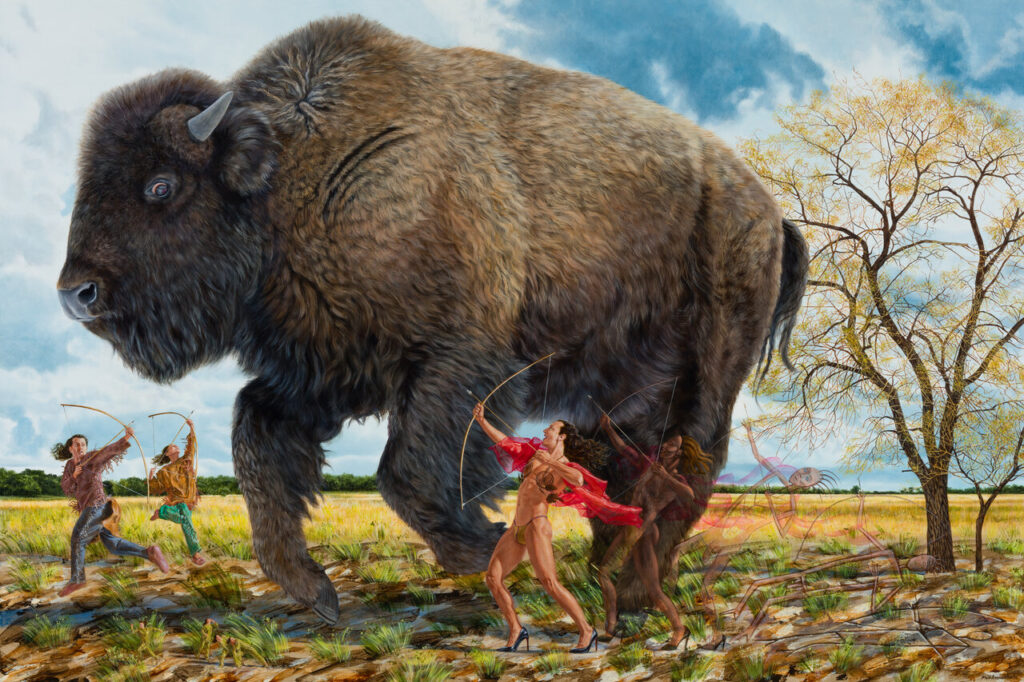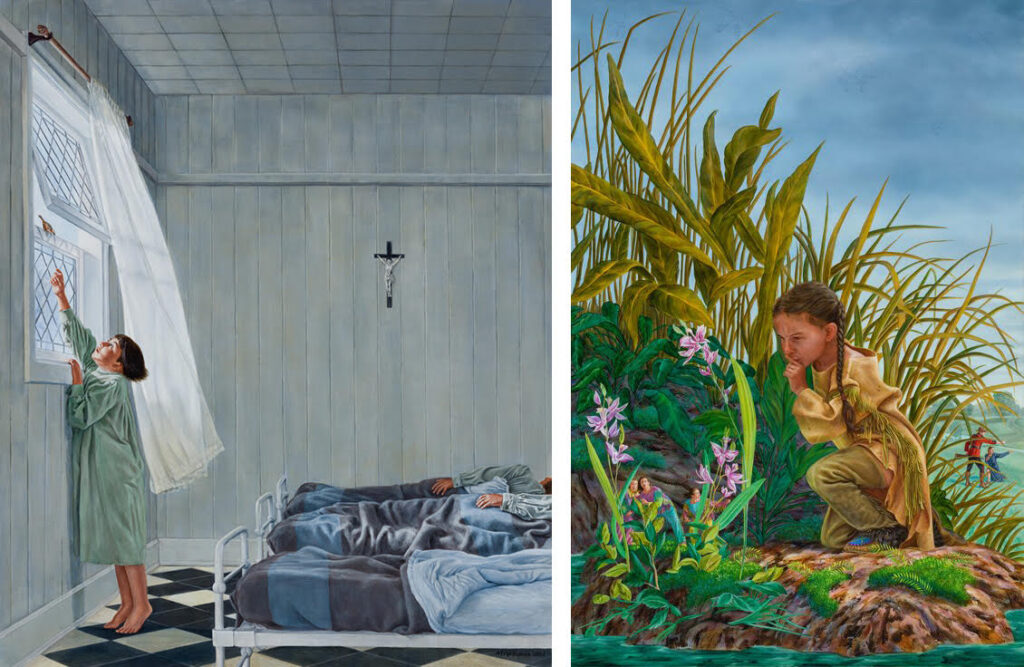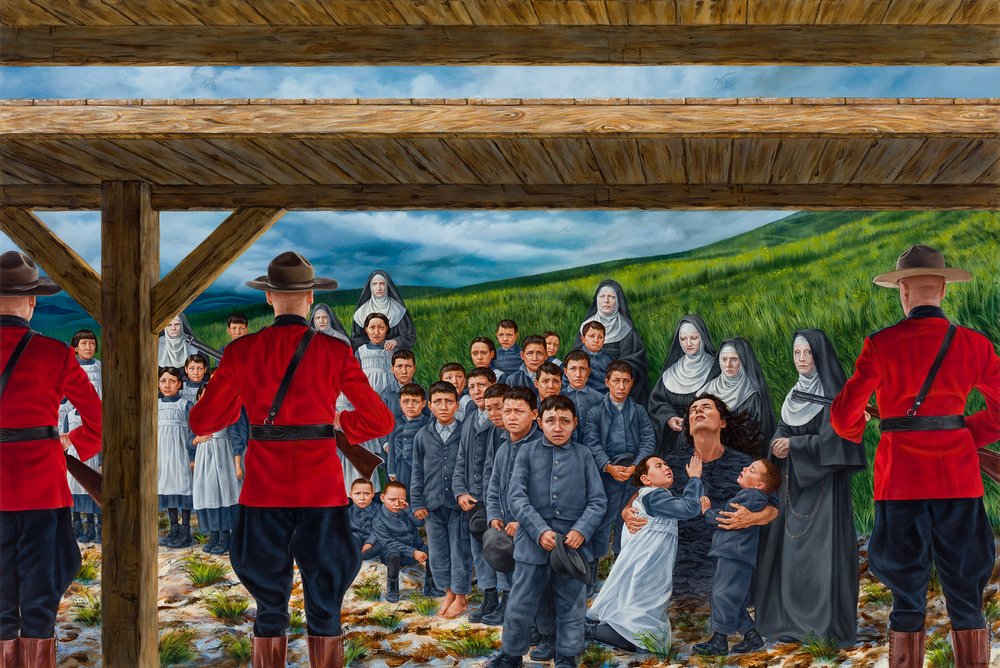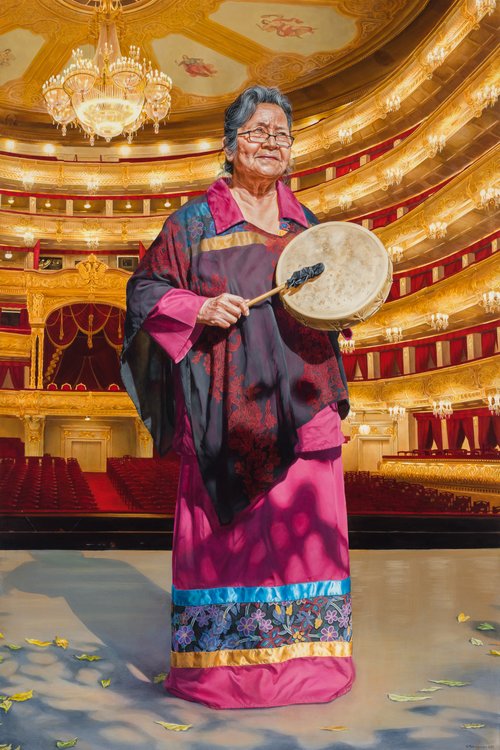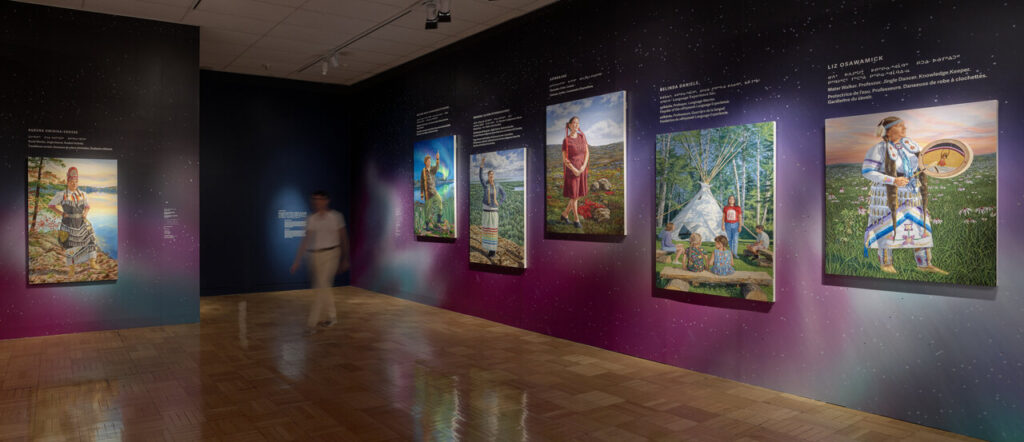The Story of Being Legendary
To start, I am not Indigenous. I recognize that I live on the ancestral territory of the Mississaugas of the Credit, the Anishnabeg, the Chippewa, the Haudenosaunee and the Huron-Wendat peoples, who are the original custodians of the land on which I write and create. As such, rather than tell you my opinion on the latest exhibition at the Royal Ontario Museum (ROM), Being Legendary, I will tell you what I learned. Far too often history assumed the origins and knowledge of the Indigenous people of this land, rather than listened to their stories.
The ROM’s latest curated exhibition, on until April 16th 2023, features, in combination, cultural belongings from the museum’s permanent collections and artworks by Kent Monkman, an Indigenous artist of the Fisher River Cree Nation. When entering the exhibition of Being Legendary, visitors are met with labels in three languages, syllabic Cree, English and French. The artist’s alter ego, Miss Chief Eagle Testickle, is the subject of many paintings, primarily in acrylic on canvas, in the exhibit. She acts as the time-traveling guide throughout the represented connections of the universe, the land, the water, and all the horrors the Indigenous peoples faced over the last several centuries. The intent, stated by Monkman, was to “challenge the histories we’ve been told…and more broadly, amplify Indigenous knowledge and experiences that often go ignored in the lands now known as Canada”.
Installation view of Kent Monkman: Being Legendary at the ROM
In brightly colored depictions, audiences are first met with paintings indicative of the objects which are displayed near them. The first example includes the labeled Horned dinosaur skull tucked just behind the entrance. Monkman used this as inspiration for a painting on the adjacent wall titled, The Rocks Hold Their Stories. As the guiding voice, Miss Chief describes the deep grief felt as they watched the bones being pried from askîy — the Earth — only to be made into a commodification of trade and display.
(L-R) Horned dinosaur skull from the collection of ROM & Kent Monkman, The Rocks Hold Their Stories, 2022, acrylic on canvas, 32” x 50.5”
Following along the route of the journey, we are met with a series of three drawings under the title Living Legends. These drawings symbolize an evolutionary pattern occurring from the tradition of the Indigenous stories to present-day interpretations. Miss Chief notes how “everything that needs to be known is embedded in our language, which comes from the land”, referencing the Indigenous elders whose knowledge of the land was often assumed, misrepresented and, more often than not, ignored altogether by settlers. One of Monkman’s paintings, Constellation of Knowledge furthers this point, speaking of the âcimowina — the stories that hold the truths and the histories of the Indigenous peoples embedded in their knowledge of the stars, spirit, medicines, ceremony, science and art — all of which were gathered from dreams, travel, observation, storytelling, reflection and creation. Grandmother Spider, the web weaver interconnecting these ideals, guards them and ensures their continuation.
Kent Monkman, I Come From pâkwan kîsik, the Hole in the Sky, 2022, acrylic on canvas, 36” x 27″
Kent Monkman, Constellation of Knowledge, 2022, acrylic on canvas, 93” x 124”
In his next work, Compositional Study for the Song of the Hunt, Monkman showcases a detailed giant buffalo roaming the plains, with bows drawn by the Indigenous hunters searching for food. Miss Chief notes again how, in Indigenous tradition, the hunters would “ask before each hunt for one to give its life to provide sustenance for [the] people. Those that agree[d] [were] honored and respected”. Long before settlers stripped the land of its resources in overhunting and fishing practices, wild buffalo roamed in great numbers along the plains. Treaties were signed to protect the Indigenous food resources across Turtle Island as settlers began to move to the West. However, it quickly became apparent that the terms of these treaties were not being adequately met.
Kent Monkman, Compositional Study for the Song of the Hunt, 2022, acrylic on canvas, 48” x 72”
Awâsisak, or children, become a symbol used often nearing one of the final sections in the exhibition. In a dimly lit, sectioned off room, you will find the painting of a child in gray clothes, in a residential school dormitory, reaching at an opened window to a small bird. This is Study for the Sparrow. Across from it, another painting titled, The Escape, depicts a girl hiding from a red uniformed soldier. In the traditional clothing of the Indigenous peoples, this girl quiets small figures that hide with her by a river bank. These works begin Monkman’s horrific recounting of the residential schools in Canada, the last of which closed only 27 years ago.
(L-R): Kent Monkman, Study for the Sparrow, 2021, acrylic on canvas, 29” x 24” & The Escape, 2021, acrylic on canvas, 60” x 40”
Beyond this space is a larger room containing 9 paintings and 8 traditional men’s shoes in glass cases. Visitors are warned upon entry that “this room may break your spirit”. The Compositional Study for The Going Away Song hangs on the far wall. It is a painting recounting the hanging of eight Indigenous men at Battleford in 1885. To be quite frank, of the eight names listed above the painting I only knew one, Wandering Spirit. As the story goes, Wandering Spirit was a young war chief from the Cree nation, under his father Chief Big Bear. In 1882, Chief Big Bear signed Treaty 6, an agreement between the Crown, the Plains and Woods Cree and the Assiniboine peoples of present-day Manitoba and Saskatchewan. The promises contained in Treaty 6 (protection from famine and pestilence as well as provision of more agricultural implements) were not honored. As the buffalo populations dwindled and left, many on the reserve were facing starvation and they became desperate. Wandering Spirit led a rebellion against the government at a small settlement at Frog Lake. Throughout the rebellion nine settlers were killed. This would later be known as the Frog Lake Massacre. Soon after, Wandering Spirit was arrested and sentenced to hang along with seven other warriors in front of the Battleford Industrial School. The terrified children in the residential school were forced to watch as their bothers and fathers were hanged. Each of the shoes in the glass cases represents one of the men who were executed that day, with corresponding paintings hanging just across from the cases.
Kent Monkman, Compositional Study for The Going Away Song, 2022, acrylic on canvas, 60” x 80”
Finally, viewers enter a room of large, brightly coloured portraits in a series he titles “Our Way Forward is Lit by Shining Stars”. Indigenous artists, teachers, mentors alike are pictured, including the Great-Great-Great Granddaughter of Wandering Spirit, Grandmother Pauline Shirt. In Toronto, she is a widely recognized figure of the Indigenous community having co-founded various establishments in hopes of inspiring the cultural traditions of her ancestors in the next generation of Indigenous youth. Monkman’s hope for the continual practice and teachings of the Indigenous peoples of Canada is made clear in this room. It focuses on the voices and leaders who aid in propelling forward stories and traditions that were once illegal on stolen land.
Portrait of Grandmother Pauline Shirt (Nimikiiquay), 2021, acrylic on canvas, 60” x 40”
Installation view of the portrait gallery
As I left this exhibition, I knew its messages deserved to be shared far and wide. Although I have many mixed emotions, I am grateful to have learned this history. It is the stories of the land we call Canada that are stepping stones from the past. They will lead us into the one future we must all share. We need only be willing to listen.
Lex Barrie
Images are courtesy of the artist and the ROM.
*Exhibition information: Kent Monkman, Being Legendary, October 8, 2022 – April 16, 2023, Royal Ontario Museum, 100 Queen’s Park, Toronto. Museum hours: Tue – Sun 10 am – 5:30 pm.

